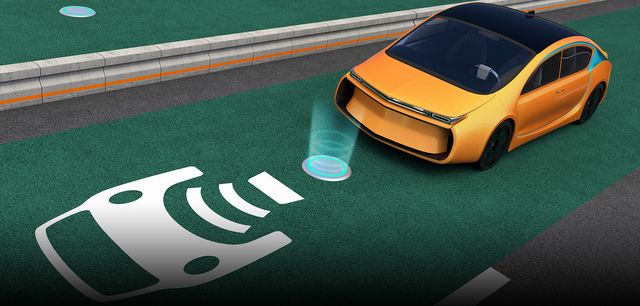21. October 2021
You may already be familiar with it from your mobile, oven or toothbrush, but the idea is to use induction to make charging electric vehicles more straightforward. Manuel Hagemann, an electromobility expert at TÜV NORD, explains how the technology works, what ensures that it is safe and which areas of application it is suitable for.
What is inductive charging?
Inductive charging is the counterpart to conductive charging using a cable connection, as is common in electric vehicles today. The energy required to charge the vehicle is not transmitted via a cable, but through the air – using induction. The charging infrastructure features a coil which is fed with electrical power, generating a magnetic field. This magnetic field is picked up in turn by a coil in the vehicle, thereby generating induction current. This is converted into direct current via an onboard charger which is stored in the traction battery.
What prevents pedestrians from getting an electric shock when they walk over an induction coil?
It goes without saying that no current is generated unless a vehicle is being charged at the time. Which is why the vehicle and the charging infrastructure have to communicate with each other before the charging process starts. For instance, a check is carried out to ensure that the car is directly above the induction coil, and only then will the current flow. What’s more, protection from electrical contact is built into the overall system: even if a cat were to run under the car during charging, it wouldn’t come to any harm. The International Commission on Non-Ionizing Radiation Protection (ICNIRP) has set appropriate limit values that must be complied with. Particularly strict limits apply whenever people with medical implants such as pacemakers might be in danger of getting too close to the inductive charging system. After all, these life-saving devices must not of course be disrupted or impaired by inductive radiation in any way. The manufacturers of these systems basically have two options: they either comply strictly with the limit values, or the system uses suitable sensors to detect that living beings or unknown objects are approaching the charging area and switches itself off accordingly.
„Whereas with inductive charging cradles for smartphones at best only 60 percent of the energy used ends up in the battery, charging systems for EVs are in fact already very efficient.“
How is the efficiency of the technology shaping up?
Whereas with inductive charging cradles for smartphones at best only 60 percent of the energy used ends up in the battery, charging systems for EVs are in fact already very efficient. According to the standard, they must achieve, at the very least, an efficiency rate of between 80 and 85 percent. However, there are already systems on the market which, so the manufacturers say, are more than 90 percent efficient. This means that they don’t fall far short of cabled charging systems, in which about 93 to 95 percent of the electricity flows into the battery.
Today’s batteries are coming with ever larger capacities and are capable of being charged ever faster using cables. In which areas do inductive systems still offer real advantages?
Here you have to distinguish between stationary inductive charging and dynamic charging while driving. Individual manufacturers such as BMW or Hyundai’s luxury brand, Genesis, have either announced the release of stationary systems for private customers or are already selling them. However, these systems offer nothing more than small gains in convenience, due to the fact that you no longer have to use a cable to start charging. Demand here is likely to depend on the price of these systems. I wouldn’t anticipate widespread demand myself. An inductive charging system could offer a real advantage for vehicles which are stationary for longer periods – not at traffic lights, perhaps, but at a taxi rank, for example. Taxi drivers usually have to wait a while before gradually moving one by one up the queue, and they often don’t enjoy the prospect of getting out of the car when it’s raining. Automatic charging by induction would be a good alternative here. However, wireless systems in the passenger car sector currently charge at a maximum of eleven kilowatts – this corresponds to the charging power of a common-or-garden wall box. By way of comparison, at a fast-charging station, appropriately equipped electric cars can already charge with up to 270 kilowatts as standard when using a cable. In research projects like those involving buses, however, inductive charging systems are already achieving outputs of over 100 kilowatts per charging module and up to 300 kilowatts in the overall system. This being the case, further progress can be expected in the passenger car sector too in the coming years.
And what about inductive charging while driving?
Dynamic charging offers the advantage that smaller batteries can be used in the vehicle, as these can be topped up when you’re driving, helping you achieve the kind of range you’d get with larger batteries. And smaller batteries mean less weight and a lower purchase price for the vehicle. In the first instance, most people tend to think about inductive charging on motorways. However, the driving speeds here are usually simply too high for the car to be able to absorb meaningful amounts of energy over shorter distances. So, this kind of system makes sense above all in urban transport, for example with buses. In this case, the induction coils are embedded in the road surface. However, the technology is still very expensive and needs to be able to withstand high loads over a long period of time. In this respect, it remains to be seen in the medium term whether the advantage of smaller batteries will outweigh the drawback of higher infrastructure costs. Basically, dynamic inductive charging is also competing with conductive charging via overhead cables. Examples of the latter include the overhead cable systems for lorries which are being tested on some motorways in Germany. Or with pantographs, which are already being used in many places for the fast top-up charging of electric buses. What ultimately prevails will be a question of costs and the intended purpose, as well as competition with other means of transport. In my opinion, contactless charging when driving will offer the greatest benefit when used in conjunction with the self-driving shuttle buses which are being tested in various German cities. These electric minibuses travel on fixed circular routes of a maximum of five kilometres. Once these buses have finally learnt to drive themselves, there will no longer be a safety driver on board, meaning that there’ll be no one to start the charging process. In this case, automatic charging using induction would of course be the best solution.
These might interest you too:
About Manuel Hagemann
© TÜV NORD
Manuel Hagemann is a technical expert for electromobility at TÜV NORD. In the TÜV Association, the mechanical engineer heads up the Electromobility Working Group.



